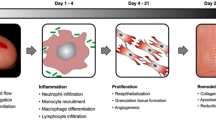Abstract
Pathological scars, including keloids and hypertrophic scars, are best managed by preventative strategies, such as occlusive silicone dressings or gels, or pressure therapies. For established lesions, intralesional corticosteroids, particularly triamcinolone acetonide (TAC) are first-line therapies. Combining TAC with intralesional 5-fluorouracil or non-pharmacological options such as lasers is generally more effective than monotherapy and may be better tolerated. Other treatments include cryotherapy, botulinum toxin type A, and more novel therapies including anti-cancer and anti-inflammatory agents. Well-designed clinical trials are needed to determine the optimal combinations and dosage regimens.
Similar content being viewed by others
References
Walsh LA, Wu E, Pontes D, et al. Keloid treatments: an evidence-based systematic review of recent advances. Syst Rev. 2023;12(1):42.
Frech FS, Hernandez L, Urbonas R, et al. Hypertrophic scars and keloids: advances in treatment and review of established therapies. Am J Clin Dermatol. 2023;24(2):225–45.
Gauglitz GG, Korting HC, Pavicic T, et al. Hypertrophic scarring and keloids: pathomechanisms and current and emerging treatment strategies. Mol Med. 2011;17(1–2):113–25.
Gianatasio C, Abrouk M, Waibel JS. Treatment approaches for treating hypertrophic scars and keloids. Dermatol Rev. 2021;2(1):11–22.
Ogawa R, Okai K, Tokumura F, et al. The relationship between skin stretching/contraction and pathologic scarring: the important role of mechanical forces in keloid generation. Wound Repair Regen. 2012;20(2):149–57.
Monstrey S, Middelkoop E, Vranckx JJ, et al. Updated scar management practical guidelines: non-invasive and invasive measures. J Plast Reconstr Aesthet Surg. 2014;67(8):1017–25.
Anzarut A, Olson J, Singh P, et al. The effectiveness of pressure garment therapy for the prevention of abnormal scarring after burn injury: a meta-analysis. J Plast Reconstr Aesthet Surg. 2009;62(1):77–84.
Ai JW, Liu JT, Pei SD, et al. The effectiveness of pressure therapy (15–25 mmHg) for hypertrophic burn scars: a systematic review and meta-analysis. Sci Rep. 2017;7:40185.
Du F, Yu Y, Zhou Z, et al. Early treatment using fractional CO2 laser before skin suture during scar revision surgery in Asians. J Cosmet Laser Ther. 2018;20(2):102–5.
Wu W, Zhao Y, Chen Y, et al. Comparing the efficacy of multiple drugs injection for the treatment of hypertrophic scars and keloid: a network meta-analysis. Aesthetic Plast Surg. 2023;47(1):465–72.
Huang L, Cai YJ, Lung I, et al. A study of the combination of triamcinolone and 5-fluorouracil in modulating keloid fibroblasts in vitro. J Plast Reconstr Aesthet Surg. 2013;66(9):e251–9.
Anderson RR, Donelan MB, Hivnor C, et al. Laser treatment of traumatic scars with an emphasis on ablative fractional laser resurfacing. JAMA Dermatol. 2014;150(2):187–93.
Seago M, Shumaker PR, Spring LK, et al. Laser treatment of traumatic scars and contractures: 2020 international consensus recommendations. Lasers Surg Med. 2020;52(2):96–116.
van Leeuwen MC, Bulstra AE, Ket JC, et al. Intralesional cryotherapy for the treatment of keloid scars: evaluating effectiveness. Plast Reconstr Surg Glob Open. 2015;3(6): e437.
O’Boyle CP, Shayan-Arani H, Hamada MW. Intralesional cryotherapy for hypertrophic scars and keloids: a review. Scars Burns Heal. 2017;3:2059513117702162.
Liu XG, Zhang D. Evaluation of efficacy of corticosteroid and corticosteroid combined with botulinum toxin type A in the treatment of keloid and hypertrophic scars: a meta-analysis. Aesthetic Plast Surg. 2021;45(6):3037–44.
Serag-Eldin YMA, Mahmoud WH, Gamea MM, et al. Intralesional pentoxifylline, triamcinolone acetonide, and their combination for treatment of keloid scars. J Cosmet Dermatol. 2021;20(10):3330–40.
Nanba K, Oura T, Soeda S, et al. Clinical evaluation of tranilast for keloid and hypertrophic scarring: optimal dose finding study in a double blind study. Nessho. 1992;18:30–45.
Abd El-Dayem DH, Nada HA, Hanafy NS, et al. Laser-assisted topical steroid application versus steroid injection for treating keloids: a split side study. J Cosmet Dermatol. 2021;20(1):138–42.
Author information
Authors and Affiliations
Corresponding author
Ethics declarations
Funding
The preparation of this review was not supported by any external funding.
Authorship and conflict of interest
C Fenton, a contracted employee of Adis International Ltd/Springer Nature, and Y. N. Lamb, a salaried employee of Adis International Ltd/Springer Nature, declare no relevant conflicts of interest. All authors contributed to this article and are responsible for its content.
Ethics approval, Consent to participate, Consent for publication, Availability of data and material, Code availability
Not applicable.
Rights and permissions
Springer Nature or its licensor (e.g. a society or other partner) holds exclusive rights to this article under a publishing agreement with the author(s) or other rightsholder(s); author self-archiving of the accepted manuscript version of this article is solely governed by the terms of such publishing agreement and applicable law.
About this article
Cite this article
Fenton, C., Lamb, Y.N. Preferably pre-empt pathological scars, or pick from a plethora of therapies. Drugs Ther Perspect 40, 22–26 (2024). https://doi.org/10.1007/s40267-023-01040-x
Accepted:
Published:
Issue Date:
DOI: https://doi.org/10.1007/s40267-023-01040-x




